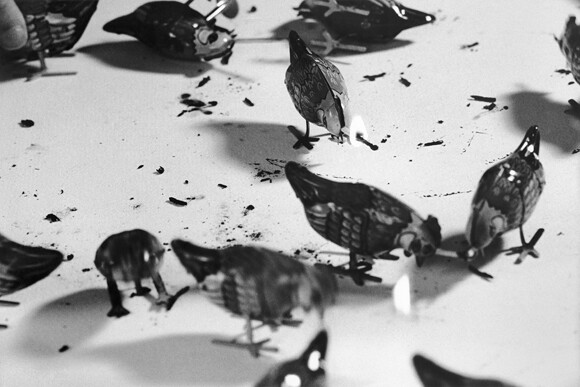Milan Grygar
Sound on paper
17 May–19 July 2014
Opening: Saturday 17 May, 18–20h
P420
Piazza dei Martiri, 5/2
40121 Bologna
Italy
T +39 0514847957
M +39 3205635213
info [at] p420.it
P420 presents the solo show Sound on paper by the artist Milan Grygar (opening on Saturday May 17, from 18h, Piazza dei Martiri 5/2, Bologna).
For about half a century, starting in the mid-1960s, Milan Grygar (b. 1926, Zvolen, Slovakia) has developed a body of work whose premise is the inseparable character of two senses occidental art has often seen as distinct: sight and hearing. His works on paper and canvas have an essential connection with sound: they record its transpiring in visual form, or constitute a more or less detailed score through which to produce it.
“I came to the certainty that what prevails in the world is correlation: sound is connected to the visual and the visual cannot exist without sound. Everything a human does is connected: visual and acoustic phenomena complement one another.”
In 1964, drawing with an unusual tool (a small stick dipped in ink), he realized that in the silent studio the tapping and tracing of the tip on the paper created an elaborate rhythm. Later, having recorded the sound on tape, it seemed just as interesting to him as the drawing that had generated it. This was the beginning of the series of Acoustic Drawings, works in which the criterion of visual composition (to trace abstract signs on a sheet of paper) and the meaning of the audio composition (the creation of given sounds in a given order) intertwine, both contributing to the final result. It is no coincidence that in the Acoustic Drawings the artist uses only black ink: in his outlook, the color is that of the absent sound, its timbre. Starting at the end of the 1960s, Grygar did performances in which he drew in real time, in front of the audience, with a range of different tools including sticks, domestic utensils, and spring toys.
In the series that have come after the Acoustic Drawings—which Grygar has nevertheless continued to make, over the decades—the initial intuition has been developed and articulated in a wide range of forms. Starting in 1967–68, Grygar has explored an opposite, complementary path with respect to that of the Acoustic Drawings: while the drawings make visually manifest a sound that has already transpired, other works have been conceived as a sort of score, from which the artist himself, armed with the same tools with which he draws, or other persons, with traditional instruments, can produce the sound compositions. These are works that establish an independent, original dialogue with the Fluxus tradition of “instruction pieces,” performances based a sets of directions someone puts into practice, and with the large current of musical scores based on visual indications of sounds of the neo-avant-gardes.
This is demonstrated in the successive series of the Sound-Plastic Drawings and Linear Score, also seen in the show. These are compositions on paper based on straight and curved parallel lines, drawn with such precision as to appear to be done by mechanical means. Inside a regular, predictable structure, the artist introduces discrepancies: the lines change color (red instead of black), orientation, position with respect to a pre-set grid. The artist thinks of these austere geometric works as true scores, with the “line as a duration,” and entrusts musicians with the development of a criterion to translate the lines in space into sounds in time.
Finally, the exhibition includes watercolors on paper, further examples of how drawing, through the factor and movement of the gesture, is connected to the temporal dimension and therefore to that of sound.
Grygar’s works have recently been shown at the Drawing Center in New York, the Museum Kampa in Prague, the Today Art Museum of Beijing and the Lyon Biennale.
The show is accompanied by video documents and a critical text by Simone Menegoi.
